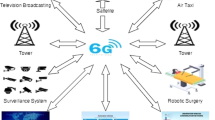Abstract
Bluetooth Low Energy (BLE) is a promising wireless network technology, in the context of body area network (BAN) applications, to provide the required quality of service support concerning the communication between sensor nodes placed on a user’s body and a personal device, such as a smartphone. Most previous BLE performance studies in the literature have focused primarily in networks with a single slave (point-to-point link) or traffic scenarios with relatively low data rate. However, many BAN sensors generate high data rate traffic, and several sensor nodes (slaves) may be actively sending data in the same BAN. Therefore, this work focuses on the evaluation of the suitability of BLE mainly under these conditions. Results show that, for the same traffic, the BLE protocol presents lower energy consumption and supports more sensor nodes than an alternative IEEE 802.15.4-based protocol. This study also identifies and characterizes some implementation constraints on the tested platforms that impose limits on the achievable performance.








Similar content being viewed by others
References
Patel, M., & Wang, J. (2010). Applications, challenges, and prospective in emerging body area networking technologies. Wireless Communications, IEEE, 17(1), 80–88.
Pantelopoulos, A., & Bourbakis, N. G. (2010). A survey on wearable sensor-based systems for health monitoring and prognosis. Systems, Man, and Cybernetics, Part C: Applications and Reviews, IEEE Transactions on, 40(1), 1–12.
Chen, M., Gonzalez, S., Vasilakos, A., Cao, H., & Leung, V. C. (2011). Body area networks: A survey. Mobile Networks and Applications, 16(2), 171–193.
Fernández-López, H., Afonso, J. A., Correia, J. H., & Simoes, R. (2012). Towards the design of efficient nonbeacon-enabled ZigBee networks. Computer Networks, 56(11), 2714–2725.
IEEE Std 802.15.4. (2011). IEEE standard for local and metropolitan area networks—Part 15.4: Low-rate wireless personal area networks (LR-WPANs).
Gislason, D. (2008). ZigBee wireless networking. Burlington, MA: Newness press.
IEEE Std 802.15.6. (2012). IEEE standard for local and metropolitan area networks—Part 15.6: Wireless body area networks.
Omre, A. H., & Keeping, S. (2010). Bluetooth low energy: Wireless connectivity for medical monitoring. Journal of Diabetes Science and Technology, 4(2), 457–463.
Jara, A. J., Fernandez, D., Lopez, P., Zamora, M. A., Gómez-Skarmeta, A. F., & Marin, L. (2013). Evaluation of bluetooth low energy capabilities for tele-mobile monitoring in home-care. Journal of Universal Computer Science, 19(9), 1219–1241.
Chan, A. M., Selvaraj, N., Ferdosi, N., & Narasimhan, R. (2013). Wireless patch sensor for remote monitoring of heart rate, respiration, activity, and falls. In 2013 35th Annual international conference of the IEEE engineering in medicine and biology society (EMBC) (pp. 6115–6118). IEEE.
Maio, A., & Afonso, J. A. (2015). Wireless cycling posture monitoring based on smartphones and bluetooth low energy. London: World Congress on Engineering.
Lin, J. R., Talty, T., & Tonguz, O. K. (2015). On the potential of bluetooth low energy technology for vehicular applications. Communications Magazine, IEEE, 53(1), 267–275.
Want, R., Schilit, B. N., & Jenson, S. (2015). Enabling the internet of things. Computer, IEEE, 48(1), 28–35.
Bandyopadhyay, D., & Sen, J. (2011). Internet of things: Applications and challenges in technology and standardization. Wireless Personal Communications, 58(1), 49–69.
Nieminen, J., Gomez, C., Isomaki, M., Savolainen, T., Patil, B., Shelby, Z., et al. (2014). Networking solutions for connecting bluetooth low energy enabled machines to the internet of things. Network, IEEE, 28(6), 83–90.
Siekkinen, M., Hiienkari, M., Nurminen, J. K., & Nieminen, J. (2012). How low energy is Bluetooth Low Energy? Comparative measurements with ZigBee/802.15.4. In 2012 IEEE wireless communications and networking conference workshops (WCNCW) (pp. 232–237). IEEE.
Gomez, C., Demirkol, I., & Paradells, J. (2011). Modeling the maximum throughput of bluetooth low energy in an error-prone link. Communications Letters, IEEE, 15(11), 1187–1189.
Mikhaylov, K., Plevritakis, N., & Tervonen, J. (2013). Performance analysis and comparison of Bluetooth Low Energy with IEEE 802.15.4 and SimpliciTI. Journal of Sensor and Actuator Networks, 2(3), 589–613.
Gomez, C., Oller, J., & Paradells, J. (2012). Overview and evaluation of bluetooth low energy: An emerging low-power wireless technology. Sensors, 12(9), 11734–11753.
Afonso, J. A., Correia, J. H., Silva, H. R., & Rocha, L. A. (2008). Body kinetics monitoring system. In International Patent WO/2008/018810A2.
Paksuniemi, M., Sorvoja, H., Alasaarela, E., & Myllyla, R. (2006). Wireless sensor and data transmission needs and technologies for patient monitoring in the operating room and intensive care unit. In 27th Annual international conference of the engineering in medicine and biology society, 2005. IEEE-EMBS 2005. (pp. 5182–5185). IEEE.
Afonso, J. A., Rocha, L. A., Silva, H. R., & Correia, J. H. (2006). MAC protocol for low-power real-time wireless sensing and actuation. In 13th IEEE International Conference on Electronics, Circuits and Systems, 2006. ICECS’06. (pp. 1248–1251). IEEE.
Afonso, J. A., Silva, H. D., Macedo, P., & Rocha, L. A. (2011). An enhanced reservation-based MAC protocol for IEEE 802.15. 4 networks. Sensors, 11(4), 3852–3873.
Bluetooth SIG. (2013). Bluetooth specification version 4.1—Master Table of Contents & Compliance Requirements.
Gomes, D., & Afonso, J. A. (2014). Improving the communication reliability of body sensor networks based on the IEEE 802.15. 4 protocol. Telemedicine and e-Health, 20(3), 261–268.
Texas Instruments. (2013). CC2540/41 bluetooth low energy software developer’s guide v1.3.2 (SWRU271F).
Texas Instruments. (2012). Measuring bluetooth low energy power consumption. Application Note ANO92.
Acknowledgments
This work has been supported by FCT (Fundação para a Ciência e Tecnologia) in the scope of the Projects UID/EEA/04436/2013 and UID/CTM/50025/2013, and by FEDER funds through the COMPETE 2020 Programme.
Author information
Authors and Affiliations
Corresponding author
Rights and permissions
About this article
Cite this article
Afonso, J.A., Maio, A.J.F. & Simoes, R. Performance Evaluation of Bluetooth Low Energy for High Data Rate Body Area Networks. Wireless Pers Commun 90, 121–141 (2016). https://doi.org/10.1007/s11277-016-3335-4
Published:
Issue Date:
DOI: https://doi.org/10.1007/s11277-016-3335-4




